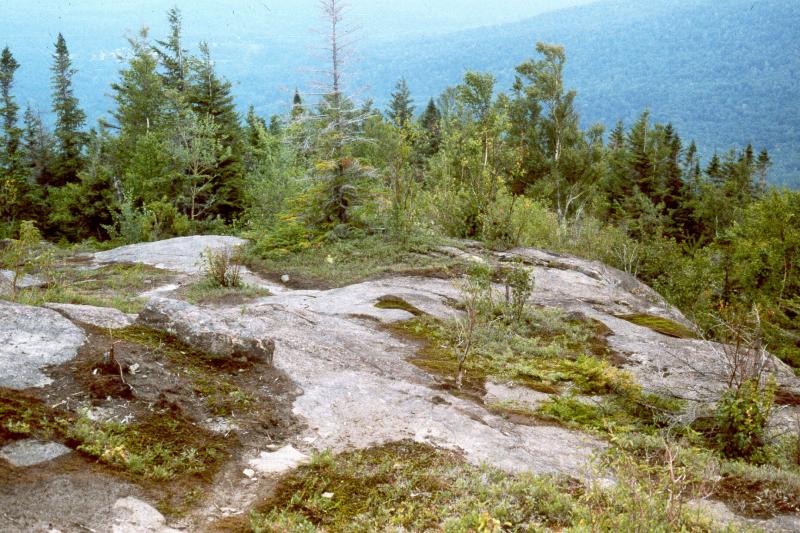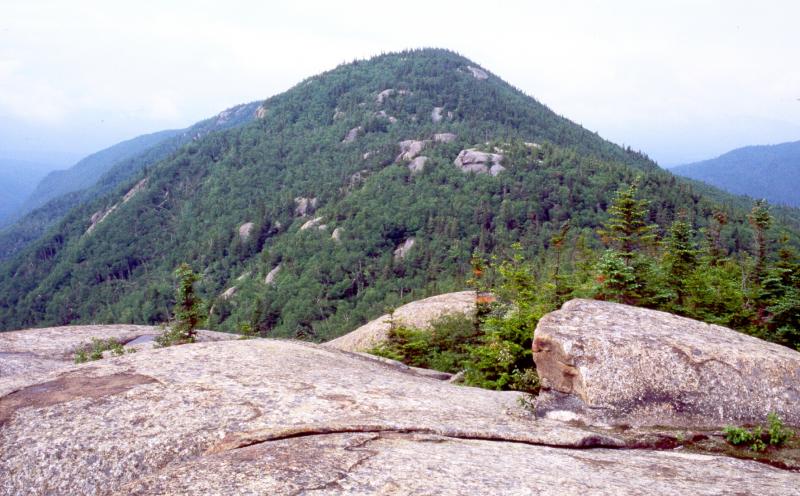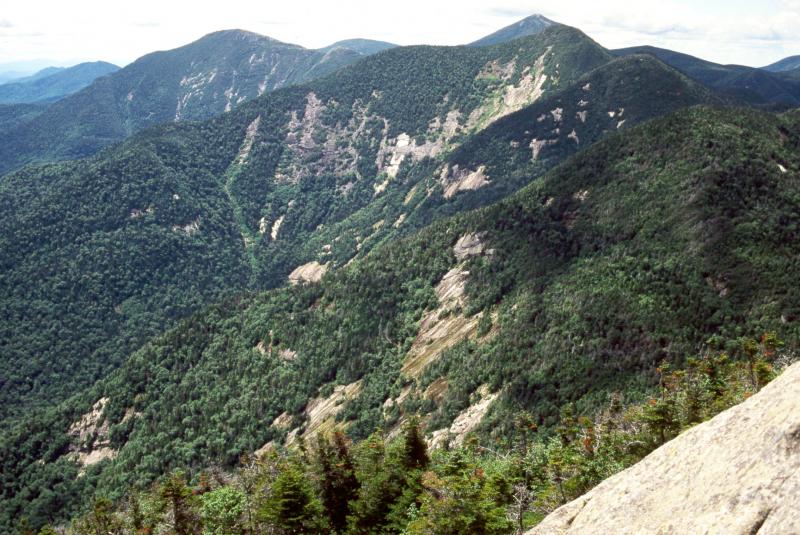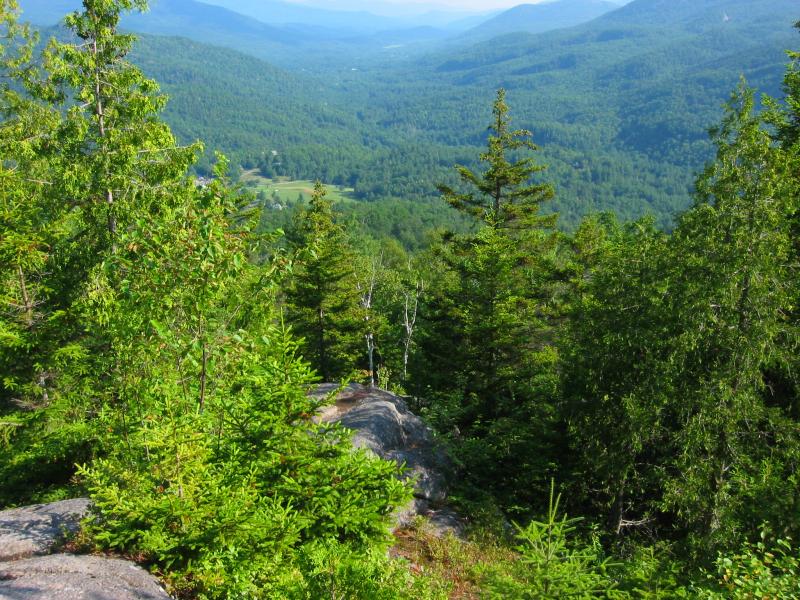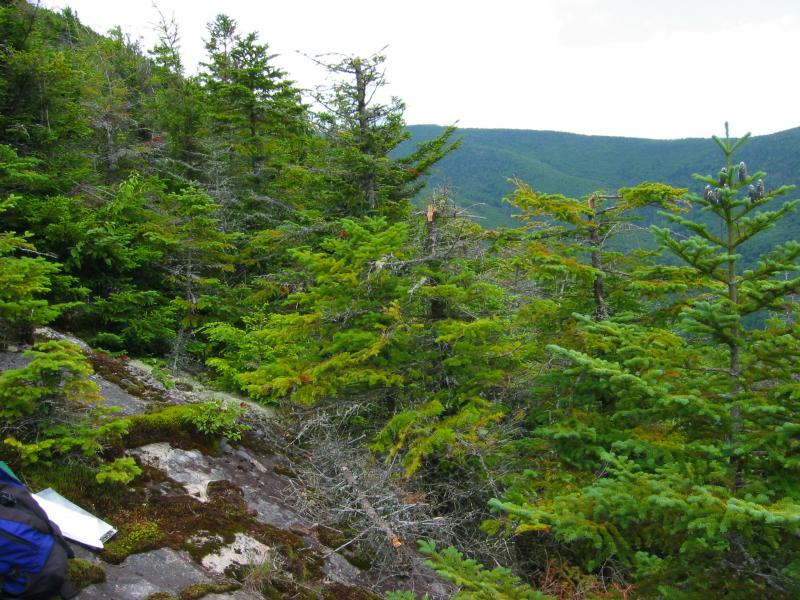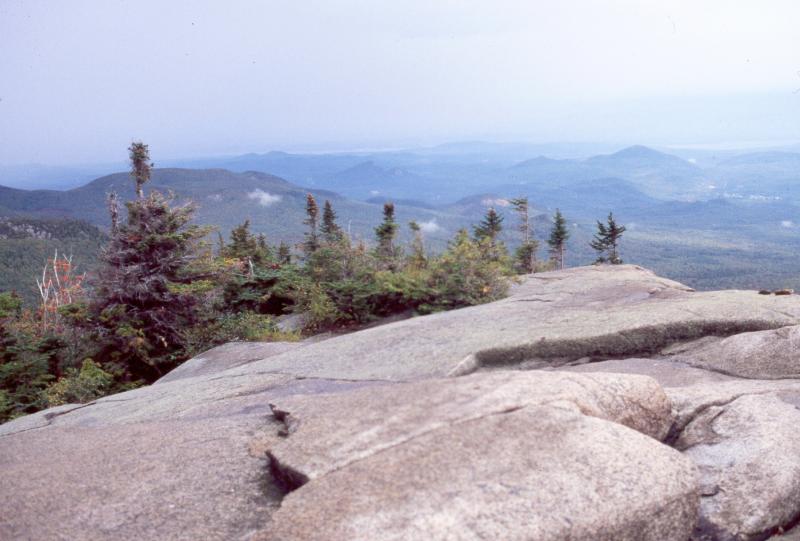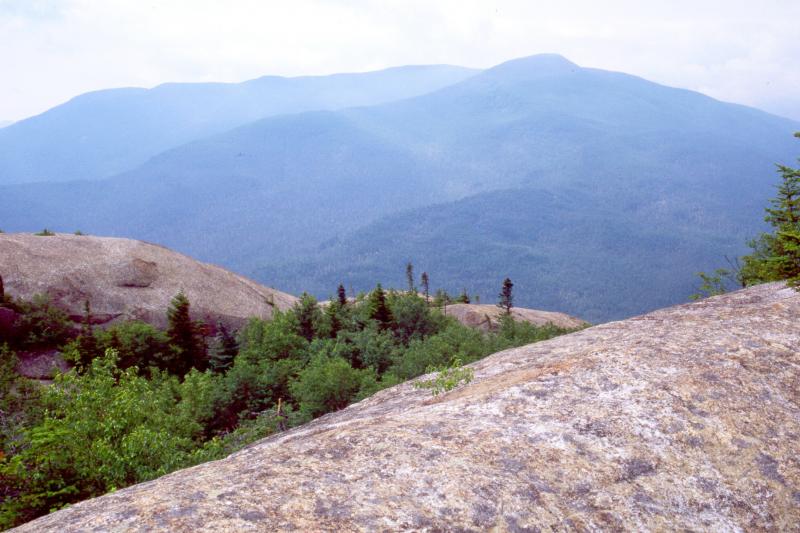Spruce-Fir Rocky Summit
- System
- Terrestrial
- Subsystem
- Barrens And Woodlands
- State Protection
- Not Listed
Not listed or protected by New York State.
- Federal Protection
- Not Listed
- State Conservation Status Rank
- S3
Vulnerable in New York - Vulnerable to disappearing from New York due to rarity or other factors (but not currently imperiled); typically 21 to 80 populations or locations in New York, few individuals, restricted range, few remaining acres (or miles of stream), and/or recent and widespread declines.
- Global Conservation Status Rank
- G4
Apparently Secure globally - Uncommon in the world but not rare; usually widespread, but may be rare in some parts of its range; possibly some cause for long-term concern due to declines or other factors.
Summary
Did you know?
The bark blisters on balsam fir contain oleoresin, used as a medium to mount microscope specimens, in the production of glue, as a cement for optical systems, and in the manufacturing of candles. Varnishes, turpentine, and balsam oil are also manufactured from this resin.
State Ranking Justification
There are a few hundred occurrences statewide. There are a few large, high quality occurrences protected on state land. This community is limited to the higher elevations of the Adirondack and Catskill Mountains. The current trend of this community is probably declining slightly due to the combined effects of atmospheric deposition and recreational overuse. This community has probably declined moderately from historical numbers likely correlated with fire suppression, development, and to a lesser extent logging.
Short-term Trends
The number and acreage of spruce-fir rocky summits in New York have probably remained stable in recent decades as a result conservation efforts at high elevation areas in the state.
Long-term Trends
The number and acreage of spruce-fir rocky summits in New York have probably declined moderately from historical numbers as a result of fire suppression, summit clearing for development, and mining of mineral resources.
Conservation and Management
Threats
Communities that occur at higher elevations in the state (e.g., >3,000 feet) may be more vulnerable to the adverse effects of atmospheric deposition and climate change, especially acid rain and temperature increase. Spruce-fir rocky summits are threatened by development on the summit and in the surrounding landscape (e.g., fire towers, residential, ski slopes) and trampling by recreational visitors (e.g., hikers, rock climbers). Given the stunted and gnarly growth form of summit trees, the community is only minimally threatened for timber resources. Summits on unprotected land may targeted for mining of mineral resources. Natural fire regimes (e.g., from lightning strikes) may be suppressed in some areas, but are apparently intact at many sites, especially in the Adirondacks. Clearing in the adjacent forest may be a threat that provides corridors for invasive plants. A few examples are threatened by invasive species, such as bluegrass (Poa compressa). Spruce budworm may be considered a threat to occurrences of spruce-fir rocky summit that experience extreme outbreaks, especially if it coincides with other stresses and reduces tree regeneration. The spruce budworm (Choristoneura fumiferana) is a native insect that creates canopy gaps in spruce and fir forests of the eastern United States and Canada. Since 1909, there have been waves of budworm outbreaks throughout the eastern United States and Canada. The states most often affected are Maine, New Hampshire, New York, Michigan, Minnesota, and Wisconsin (Kucera and Orr 1981). Balsam fir is the primary host tree for budworm in the eastern United States, although white, red, and black spruce are known to be suitable host trees. Spruce budworm may also feed on tamarack, pine, and hemlock. Spruce mixed with balsam fir is more likely to show signs of budworm infestation than spruce in pure stands (Kucera and Orr 1981). Mountain spruce-fir forests are threatened by acid rain deposition. The ability of forest soils to resist, or buffer, acidity depends on the thickness and composition of the soil, as well as the type of bedrock beneath the forest floor. Places in the mountainous Northeast, like New York's Adirondack and Catskill Mountains, have thin soils with low buffering capacity. Forests in high mountain regions are often exposed to greater amounts of acid than other forests because they tend to be surrounded by acidic clouds and fog that are more acidic than rainfall. When leaves are frequently bathed in this acid fog, essential nutrients in their leaves and needles are stripped away. This loss of nutrients in their foliage makes trees more susceptible to damage by other environmental factors, particularly cold winter weather (US EPA 2005).
Conservation Strategies and Management Practices
Management activities should include the development and implementation of prescribed burn plans at appropriate sites. Fragmenting features such as roads, abandoned tower clearings, and unnecessary trails should be reduced or minimized, and high-impact activities such as mountain biking and hang-gliding should be restricted to trails and least sensitive areas. Prevent the dumping of trash and off-trail trampling at heavily visited summits. Management should focus on activities that help maintain regeneration of the species associated with this community. Management activities should be consistent with recommendations presented in the High Peaks Wilderness Unit Management Plan (NYS DEC 1999). Prevent the dumping of trash and off-trail trampling at heavily visited summits.
Development and Mitigation Considerations
Soils are very thin in and around this community and the effect of clearing and construction on soil retention and erosion must be considered during any development activities. Similarly, these soils are acidic and nutrient-poor and any soil enrichment contamination (e.g., from septic leach fields or fertilized lawns) can alter community structure and function. The open structure of this community is maintained by fire and presents a fire hazard to existing and proposed development. Unprotected structures located within or near this community are more susceptible to damage from fire.
Inventory Needs
Survey for new occurrences in the Adirondacks and Catskill mountains in order to advance documentation and classification of mountain spruce-fir rocky summits. A statewide review of alpine and high elevation (>3,000 feet) communities is desirable. Continue searching for large sites in good condition (A- to AB-ranked).
Research Needs
Research the long term combined effects that atmospheric deposition, climate change, and extreme budworm outbreaks may have on mountain spruce-fir forest occurrences. Plot data are needed to help clearly separate this community from similar types, such as alpine krummholz and mountain spruce-fir forest.
Rare Species
Range
New York State Distribution
This community is limited to the Adirondack and Catskill Mountains. Concentrated in the Adirondack Mountains where it reaches large patch size in a few occurrences on mountains which underwent large historical fires. Only a few small patch occurrences are suspected from the Catskill Mountains.
Global Distribution
This community spans north to Quebec, west to Ontario, south to North Carolina and Tennessee, and east to Nova Scotia.
Best Places to See
- North Mountain Wild Forest, Catskill Park (Greene County)
- Hurricane Primitive Area, Adirondack Park
- Slide Mountain-Panther Mountain Wilderness Area, Catskill Park (Ulster County)
- Lake George Wild Forest, Adirondack Park (Warren, Washington Counties)
Identification Comments
General Description
An open canopy woodland dominated by red spruce (Picea rubens) and balsam fir (Abies balsamea) that occurs on non-calcareous rocky outcrops and summits in boreal or high elevation areas. Other trees and shrubs may include eastern hemlock (Tsuga canadensis), mountain paper birch (Betula cordifolia), mountain ash (Sorbus americana), and blueberry (Vaccinium angustifolium, V. myrtilloides). On the woodland floor, herbs such as bunchberry (Cornus canadensis), harebell (Campanula rotundifolia), and common hairgrass (Deschampsia flexuosa), and several species of mosses and lichens may be present.
Characters Most Useful for Identification
Spruce-fir rocky summits are located in the Catskill and Adirondack Mountains, on non-calcareous rocky outcrops and summits. The relatively open canopy is dominated by red spruce and balsam fir, and the associated vegetation may be sparse and patchy, with numerous rock outcrops and slides.
Elevation Range
Known examples of this community have been found at elevations between 1,400 feet and 4,626 feet.
Best Time to See
Flowers and grasses may be in bloom throughout the growing season, and blueberries may be present during midsummer.
Spruce-Fir Rocky Summit Images
Classification
International Vegetation Classification Associations
This New York natural community encompasses all or part of the concept of the following International Vegetation Classification (IVC) natural community associations. These are often described at finer resolution than New York's natural communities. The IVC is developed and maintained by NatureServe.
- Red Spruce / Lowbush Blueberry / Three-toothed Cinquefoil Woodland (CEGL006053)
- Jack Pine / Sheep Laurel - Blueberry species Woodland (CEGL006041)
- Lowbush Blueberry - American Mountain-ash / Three-toothed Cinquefoil Dwarf-shrubland (CEGL005094)
NatureServe Ecological Systems
This New York natural community falls into the following ecological system(s). Ecological systems are often described at a coarser resolution than New York's natural communities and tend to represent clusters of associations found in similar environments. The ecological systems project is developed and maintained by NatureServe.
- Acadian-Appalachian Subalpine Woodland and Heath-Krummholz (CES201.568)
- Central Appalachian Pine-Oak Rocky Woodland (CES202.600)
- Northern Appalachian-Acadian Rocky Heath Outcrop (CES201.571)
Characteristic Species
-
Trees > 5m
- Abies balsamea (balsam fir)
- Betula cordifolia (mountain paper birch)
- Picea rubens (red spruce)
- Sorbus americana (American mountain-ash)
- Tsuga canadensis (eastern hemlock)
-
Shrubs < 2m
- Vaccinium angustifolium (common lowbush blueberry)
- Vaccinium myrtilloides (velvet-leaved blueberry)
-
Herbs
- Avenella flexuosa (common hair grass)
- Campanula rotundifolia (hare-bell)
- Cornus canadensis (bunchberry)
- Oclemena acuminata (whorled wood-aster)
- Piptatheropsis pungens (short-awned rice grass)
- Solidago macrophylla (large-leaved goldenrod)
- Solidago randii (Rand's goldenrod)
-
Nonvascular plants
- lichen
- moss
Similar Ecological Communities
- Alpine krummholz
(guide)
Alpine krummholz is dominated (50-85%) by stunted (<1.5 m) balsam fir often forming a dense thicket. Spruce-fir rocky summits have patchy vegetation dominated by red spruce and balsam fir with numerous rock outcrops.
- Mountain spruce-fir forest
(guide)
While both communities are co-dominated by red spruce and balsam fir, mountain spruce-fir forests have 60% or greater tree canopy cover (>5 m) and spruce-fir rocky summits have tree cover 25-60% with numerous rock outcrops.
- Northern white cedar rocky summit
(guide)
Unlike spruce-fir rocky summits, northern white cedar rocky summit communities occur on calcareous rocky outcrops, such as limestone and dolomite. The canopy is dominated by northern white cedar (Thuja occidentalis), American basswood (Tilia americana), and eastern hop hornbeam (Ostrya virginiana). Spruce-fir rocky summit is a boreal high elevation community of cooler sites, dominated by spruce and fir.
- Pitch pine-oak-heath rocky summit
(guide)
Like spruce-fir rocky summits, pitch pine-oak-heath rocky summit communities are located on non-calcareous rocky outcrops and summits, but they are dominated by pines, oaks, and heath species, and have a wider geographical range of occurrence. Spruce-fir rocky summit is a boreal high elevation community of cooler sites, dominated by spruce and fir.
- Red cedar rocky summit
(guide)
Unlike spruce-fir rocky summits, red cedar rocky summit communities occur on warm calcareous rocky outcrops, such as limestone, dolomite, and marble. The canopy is dominated by eastern red cedar (Juniperus virginiana), red oak (Quercus rubra), hickories (Carya spp.), and white ash (Fraxinus americana). The herb layer is often quite diverse. Spruce-fir rocky summit is a boreal high elevation community of cooler sites, dominated by spruce and fir.
- Red pine rocky summit
(guide)
Like spruce-fir rocky summits, red pine rocky summit communities are located on non-calcareous rocky outcrops and summits, but they are dominated by pines, oaks, and heath species. Spruce-fir rocky summit is a boreal high elevation community of cooler sites, dominated by spruce and fir.
- Rocky summit grassland
(guide)
Rocky summit grasslands are open communities dominated by grasses such as little bluestem (Schizachyrium scoparium), Indian grass (Sorghastrum nutans), hairgrass (Deschampsia flexuosa), and poverty-grasses (Danthonia spp.). Trees are very sparse. Spruce-fir rocky summit is a boreal high elevation woodland community of cooler sites, dominated by spruce and fir.
Vegetation
Percent cover
This figure helps visualize the structure and "look" or "feel" of a typical Spruce-Fir Rocky Summit. Each bar represents the amount of "coverage" for all the species growing at that height. Because layers overlap (shrubs may grow under trees, for example), the shaded regions can add up to more than 100%.
Additional Resources
References
Edinger, G. J., D. J. Evans, S. Gebauer, T. G. Howard, D. M. Hunt, and A. M. Olivero (editors). 2014. Ecological Communities of New York State. Second Edition. A revised and expanded edition of Carol Reschke’s Ecological Communities of New York State. New York Natural Heritage Program, New York State Department of Environmental Conservation, Albany, NY. https://www.nynhp.org/ecological-communities/
Edinger, Gregory J., D.J. Evans, Shane Gebauer, Timothy G. Howard, David M. Hunt, and Adele M. Olivero (editors). 2002. Ecological Communities of New York State. Second Edition. A revised and expanded edition of Carol Reschke's Ecological Communities of New York State. (Draft for review). New York Natural Heritage Program, New York State Department of Environmental Conservation. Albany, NY. 136 pp.
Gemborys, S.R. (undated). Structure, dynamics, and pattern in a virgin northern hardwood-spruce-fir forest, The Bowl, New Hampshire. Unpublished report. Dept. biology, Hampden-Sydney College. Hampden-sydney, VA. 71 pp.
Kucera, D.R. and P.W. Orr. 1981. Spruce budworm in the eastern United States. Forest Insect and Disease Leaflet 160. U.S. Department of Agriculture, Forest Service, Washington, D.C.
Kudish, M. 1971. Vegetational history of the Catskill High Peaks. Dissertation Abstracts 1971, No. 71-30, 100, 270 pp.
McIntosh, R.P. and R.J. Hurley. 1964. The spruce fir forests of the Catskill Mountains. Ecology 45:314-326.
Mohler, C.L., P.L. Marks, and D.G. Sprugel. 1978. Stand structure and allometry of trees during self-thinning of pure stands. J. Ecol. 66:599-614.
New York Natural Heritage Program. 2024. New York Natural Heritage Program Databases. Albany, NY.
New York State Department of Environmental Conservation. 1999. High Peaks Wilderness Complex Unit Management Plan: Wilderness management for the High Peaks of the Adirondack Park. New York State Department of Environmental Conservation. Albany, NY.
Nicholson, S. 1965. Altitudinal and exposure variations of the spruce-fir forest on Whiteface Mountain. M.S. Thesis, State University of New York Albany.
Rabenold, K.N. 1978. Foraging stategies, diversity, and seasonality in bird communities of Appalachian spruce-fir forests. Ecological Monographs 48(4):397-424
Reschke, Carol. 1990. Ecological communities of New York State. New York Natural Heritage Program, New York State Department of Environmental Conservation. Latham, NY. 96 pp. plus xi.
Rimmer, C.C., K.P. McFarland, W.P. Ellison, and J.E. Goetz. 2001. Bicknell's Thrush (Catharus bicknelli). In The Birds of North of America, No. 592 (A. Poole and F. Gill, eds.). The Birds of North America, Inc, Philadelphia, PA.
Scott, J.T., T.G. Siccama, A.H. Johnson, and A.R. Breisch. 1984. Decline of red spruce in the Adirondacks. Bull. Torrey Botanical Club 111(4):438-444.
Slack, Nancy G. 1977. Species diversity and community structure in bryophytes: New York State Studies. New York State Museum Bull. 428.
Sperduto, D.D. and C.V. Cogbill. 1999. Alpine and subalpine vegetation of the White Mountains, New Hampshire. New Hampshire Natural Heritage Inventory, Concord, New Hampshire.
United States Envoronmental Protection Agency. 2005. Effects of Acid Rain: Forests. Available on line at http:www.epa.gov/airmarkets/acidrain/effects/forests.html Accessed March 2, 2005.
Vogelmann, H.W. 1985. Forest decline on Camels Hump, Vermont. Bull. Torrey Botanical Club 112(3):274-287.
Zon, R. 1914. Balsam fir. Bull. U.S. Department Agriculture No. 55:1-68.
Links
About This Guide
This guide was authored by: Timothy G. Howard
Information for this guide was last updated on: November 15, 2023
Please cite this page as:
New York Natural Heritage Program. 2024.
Online Conservation Guide for
Spruce-fir rocky summit.
Available from: https://guides.nynhp.org/spruce-fir-rocky-summit/.
Accessed July 27, 2024.
